Study of the Tribological Properties of HVOF-Sprayed Ni-Based Coatings on Ti6Al4V Titanium Alloys
Abstract
:1. Introduction
2. Experimental Section
2.1. Experimental Methods and Materials
2.2. Microstructure and Performance Characterization
3. Results and Discussion
3.1. Coating Microstructure
3.2. The Phase Structure
3.3. Coating Mechanical Properties
3.4. Tribology Properties of Coatings in Friction with Ti6Al4V
3.4.1. Friction Coefficient
3.4.2. Wear Loss
3.4.3. Wear Morphology and Wear Mechanism
4. Conclusions
Author Contributions
Funding
Institutional Review Board Statement
Informed Consent Statement
Data Availability Statement
Acknowledgments
Conflicts of Interest
References
- Zhang, W.; Li, W.; Zhai, H.; Wu, Y.; Wang, S.; Liang, G.; Wood, R.J.K. Microstructure and tribological properties of laser in-situ synthesized Ti3Al composite coating on Ti-6Al-4V. Surf. Coat. Technol. 2020, 395, 125944. [Google Scholar] [CrossRef]
- Xu, G.; Shen, X. Fabrication of SiO2 nanoparticles incorporated coating onto titanium substrates by the micro-arc oxidation to improve the wear resistance. Surf. Coat. Technol. 2019, 364, 180–186. [Google Scholar] [CrossRef]
- Yuan, S.; Lin, N.M.; Zou, J.J.; Lin, X.Z.; Liu, Z.Q.; Yu, Y.; Wang, Z.X.; Zeng, Q.F.; Chen, W.G.; Tian, L.H.; et al. In-situ fabrication of gradient titanium oxide ceramic coating on laser surface textured Ti6Al4V alloy with improved mechanical property and wear performance. Vacuum 2020, 176, 109327. [Google Scholar] [CrossRef]
- Ma, A.; Liu, D.X.; Tang, C.B.; Zhang, X.H.; Liu, C.S. Influence of glow plasma Co-based alloying layer on sliding wear and fretting wear resistance of titanium alloy. Tribol. Int. 2018, 12, 85–94. [Google Scholar] [CrossRef]
- Mary, C.; Fouvry, S.; Martin, J.M.; Bonnet, B. Pressure and temperature effects on fretting wear damage of a Cu-Ni-In plasma coating versus Ti17 titanium alloy contact. Wear 2011, 272, 18–37. [Google Scholar] [CrossRef]
- Bansal, D.G.; Eryilmaz, O.L.; Blau, P.J. Surface engineering to improve the durability and lubricity of Ti-6Al-4V alloy. Wear 2011, 271, 2006–2015. [Google Scholar] [CrossRef]
- Ananth, M.P.; Ramesh, R. Sliding wear characteristics of solid lubricant coating on titanium alloy surface modified by laser texturing and ternary hard coatings. T. Nonferr. Metal. Soc.China 2017, 27, 839–847. [Google Scholar] [CrossRef]
- Park, Y.G.; Wey, M.Y.; Hong, S.I. Enhanced wear and fatigue properties of Ti-6Al-4V alloy modified by plasma carburizing/CrN coating. J Mater Sci. Mater Med. 2007, 18, 925–931. [Google Scholar] [CrossRef]
- Friedrich, V.; Fouvry, S.; Kapsa, P. Effect of shot peening on the fretting wear of Ti-6Al-4V. Wear 2001, 250, 642–649. [Google Scholar] [CrossRef]
- Karaoglanli, A.C. Effect of severe air-blast shot peening on the wear characteristics of CP titanium. Mater. Tehnol. 2015, 49, 253–258. [Google Scholar] [CrossRef]
- Ma, A.; Liu, D.X.; Zhang, X.H.; He, G.Y.; Liu, D.; Liu, C.S.; Xu, X.C. The fretting fatigue performance of Ti-6Al-4V alloy influenced by microstructure of CuNiIn coating prepared via thermal spraying. Tribol. Int. 2020, 145, 106156. [Google Scholar] [CrossRef]
- Pawlak, W.; Kubiak, K.J.; Wendler, B.G.; Mathiac, T.G. Wear resistant multilayer nanocomposite WC1-x/C coating on Ti-6Al-4V titanium alloy. Tribol. Int. 2015, 82, 400–406. [Google Scholar] [CrossRef] [Green Version]
- Łępicka, M.; Grądzka-Dahlke, M.; Pieniak, D.; Pasierbiewicz, K.; Kryńska, K.; Niewczas, A. Tribological performance of titanium nitride coatings: A comparative study on TiN-coated stainless steel and titanium alloy. Wear 2019, 422, 68–80. [Google Scholar] [CrossRef]
- Yang, Y.L.; Zhang, D.; Yan, W.; Zheng, Y.R. Microstructure and wear properties of TiCN/Ti coatings on titanium alloy by laser cladding. Opt. Laser Eng. 2010, 48, 119–124. [Google Scholar] [CrossRef]
- Santecchia, E.; Hamouda, A.M.S.; Musharavati, F.; Zalnezhad, E.; Cabibbo, M.; Stefano, S. Wear resistance investigation of titanium nitride-based coatings. Ceram. Int. 2015, 41, 10349–10379. [Google Scholar] [CrossRef]
- Xiang, K.; Chen, L.Y.; Chai, L.J.; Guo, N.; Wang, N.; Wang, H. Microstructural characteristics and properties of CoCrFeNiNbx high-entropy alloy coatings on pure titanium substrate by pulsed laser cladding. Appl. Surf. Sci. 2020, 517, 146214. [Google Scholar] [CrossRef]
- Thirumalvalavan, S.; Senthilkumar, N.; Perumal, G.; Anantha, P.M.R. Ameliorating the wear defiance of HVOF thermal spray silicon carbide coated Ti-6Al-4V alloy using PCA-GRA technique. Silicon 2022, 14, 3101–3117. [Google Scholar] [CrossRef]
- Li, W.; Xu, P.Q.; Wang, Y.Y.; Zou, Y.; Gong, H.Y.; Lu, F.G. Laser synthesis and microstructure of micro-and nano-structured WC reinforced Co-based cladding layers on titanium alloy. J. Alloy. Compd. 2018, 749, 10–22. [Google Scholar] [CrossRef]
- Li, Y.S.; Song, P.; Wang, W.Q.; Lei, M.; Li, X.W. Microstructure and wear resistance of a Ni-WC composite coating on titanium grade 2 obtained by electroplating and electron beam remelting. Mater. Charact. 2020, 170, 110674. [Google Scholar] [CrossRef]
- Niu, Z.Q.; Zhou, W.L.; Wang, C.L.; Cao, Z.W.; Yang, Q.; Fu, X.S. Fretting wear mechanism of plasma-sprayed CuNiIn coating on Ti-6Al-4V substrate under plane/plane contact. Surf. Coat. Tech. 2021, 408, 126794. [Google Scholar] [CrossRef]
- Freimanis, A.J.; Segall, A.E.; Conway, J.C.; Whitney, E.J. Elevated temperature evaluation of fretting and metal transfer between coated titanium components. Tribol. T. 2000, 43, 653–658. [Google Scholar] [CrossRef]
- Zaghloul, M.M.Y.; Steel, K.; Veidt, M.; Heitzmann, M.T. Wear behaviour of polymeric materials reinforced with man-made fibres: A comprehensive review about fibre volume fraction influence on wear performance. J Reinf. Plast. Comp. 2022, 41, 215–241. [Google Scholar] [CrossRef]
- Zaghloul, M.Y.M.; Zaghloul, M.M.Y.; Zaghloul, M.M.Y. Developments in polyester composite materials–An in-depth review on natural fibres and nano fillers. Compos Struct. 2021, 278, 114698. [Google Scholar] [CrossRef]
- Deshpande, S.; Kulkarni, A.; Sampath, S.; Herman, H. Application of image analysis for characterization of porosity in thermal spray coatings and correlation with small angle neutron scattering. Surf. Coat. Technol. 2004, 187, 6–16. [Google Scholar] [CrossRef]
- Evans, A.G.; Wilshaw, T.R. Quasi-static solid particle damage in brittle solid-I. Observations analysis and implications. Acta Metall. 1976, 24, 939–956. [Google Scholar] [CrossRef]
- Żórawski, W.; Skrzypek, S.J. Tribological properties of plasma and HVOF-sprayed NiCrBSi-Fe2O3 composite coatings. Surf. Coat. Technol. 2013, 220, 282–289. [Google Scholar] [CrossRef]
- Tillmann, W.; Hussong, B.; Priggemeier, T.; Kuhnt, S.; Rudak, N.; Weinert, H. Influence of parameter variations on WC-Co splat formation in an HVOF process using a new beam-shutter device. J. Therm. Spray Technol. 2013, 22, 250–262. [Google Scholar] [CrossRef]
- Karaoglanli, A.C.; Oge, M.; Doleker, K.M.; Hotamis, M. Comparison of tribological properties of HVOF sprayed coatings with different composition. Surf. Coat. Technol. 2017, 318, 299–308. [Google Scholar] [CrossRef]
- Cho, T.Y.; Yoon, J.H.; Cho, J.Y.; Joo, Y.K.; Kang, J.H.; Zhang, S.H.; Chun, H.G.; Hwang, S.Y.; Kwon, S.C. Surface properties and tensile bond strength of HVOF thermal spray coatings of WC-Co powder onto the surface of 420J2 steel and the bond coats of Ni, NiCr, and Ni/NiCr. Surf. Coat. Technol. 2009, 203, 3250–3253. [Google Scholar] [CrossRef]
- Chen, E.T.; Barnett, R.N.; Landman, U. Surface melting of Ni (110). Phys. Rev. B 1990, 41, 439. [Google Scholar] [CrossRef] [PubMed]
- Somervuori, M.; Varis, T.; Oksa, M.; Suhonen, T.; Vuoristo, P. Comparative study on the corrosion performance of APS-, HVOF-, and HVAF-sprayed NiCr and NiCrBSi coatings in NaCl solutions. J. Therm. Spray. Techn. 2022, 31, 1597–1851. [Google Scholar] [CrossRef]
- Dash, T.; Nayak, B.B. Preparation of WC–W2C composites by arc plasma melting and their characterisations. Ceram. Int. 2013, 39, 3279–3292. [Google Scholar] [CrossRef]
- Guo, H.J.; Li, B.; Lu, C.; Zhou, Q.; Jia, J.H. Effect of WC-Co content on the microstructure and properties of NiCrBSi composite coatings fabricated by supersonic plasma spraying. J. Alloy. Compd. 2019, 789, 966–975. [Google Scholar] [CrossRef]
- Sang, P.; Chen, L.Y.; Zhao, C.H.; Wang, Z.X.; Wang, H.Y.; Lu, S.; Song, D.P.; Xu, J.H.; Zhang, L.C. Particle size-dependent microstructure, hardness and electrochemical corrosion behavior of atmospheric plasma sprayed NiCrBSi coatings. Metals 2019, 9, 1342. [Google Scholar] [CrossRef] [Green Version]
- Deshpande, S.; Sampath, S.; Zhang, H. Mechanisms of oxidation and its role in microstructural evolution of metallic thermal spray coatings—Case study for Ni-Al. Surf. Coat. Technol. 2006, 200, 5395–5406. [Google Scholar] [CrossRef]
- Wang, Y.Y.; Li, C.J.; Ohmori, A. Influence of substrate roughness on the bonding mechanisms of high velocity oxy-fuel sprayed coatings. Thin Solid Films 2005, 485, 141–147. [Google Scholar] [CrossRef]
- Rachidi, R.; Kihel, B.; Delaunois, F. Microstructure and mechanical characterization of NiCrBSi alloy and NiCrBSi-WC composite coatings produced by flame spraying. Mater. Sci. Eng. B. 2019, 241, 13–21. [Google Scholar] [CrossRef]
- Liu, J.; Bai, X.Q.; Chen, T.Z.; Yuan, C.Q. Effects of cobalt content on the microstructure, mechanical properties and cavitation erosion resistance of HVOF sprayed coatings. Coatings 2019, 9, 534. [Google Scholar] [CrossRef] [Green Version]
- Chivavibul, P.; Watanabe, M.; Kuroda, S.; Shinoda, K. Effects of carbide size and Co content on the microstructure and mechanical properties of HVOF-sprayed WC-Co coatings. Surf. Coat. Technol. 2007, 202, 509–521. [Google Scholar] [CrossRef]
- Zhu, X.P.; Du, P.C.; Meng, Y.; Lei, M.K.; Guo, D.M. Solution to inverse problem of manufacturing by surface modification with controllable surface integrity correlated to performance: A case study of thermally sprayed coatings for wear performance. J. Tribol. T. ASME 2017, 139, 061604. [Google Scholar] [CrossRef]
- Long, M.; Rack, H.J. Friction and surface behavior of selected titanium alloys during reciprocating-sliding motion. Wear 2001, 249, 158–168. [Google Scholar] [CrossRef]
- Magaziner, R.S.; Jain, V.K.; Mall, S. Investigation into the wear of Ti-6Al-4V under reciprocating sliding conditions. Wear 2009, 267, 368–373. [Google Scholar] [CrossRef]
- Miguel, J.M.; Guilemany, J.M.; Vizcaino, S. Tribological study of NiCrBSi coating obtained by different processes. Tribol. Int. 2003, 36, 181–187. [Google Scholar] [CrossRef]
- Xiao, J.K.; Wu, Y.Q.; Zhang, W.; Chen, J.; Wei, X.L.; Zhag, C. Microstructure, wear and corrosion behaviors of plasma sprayed NiCrBSi-Zr coating. Surf. Coat. Technol. 2019, 360, 172–180. [Google Scholar] [CrossRef]
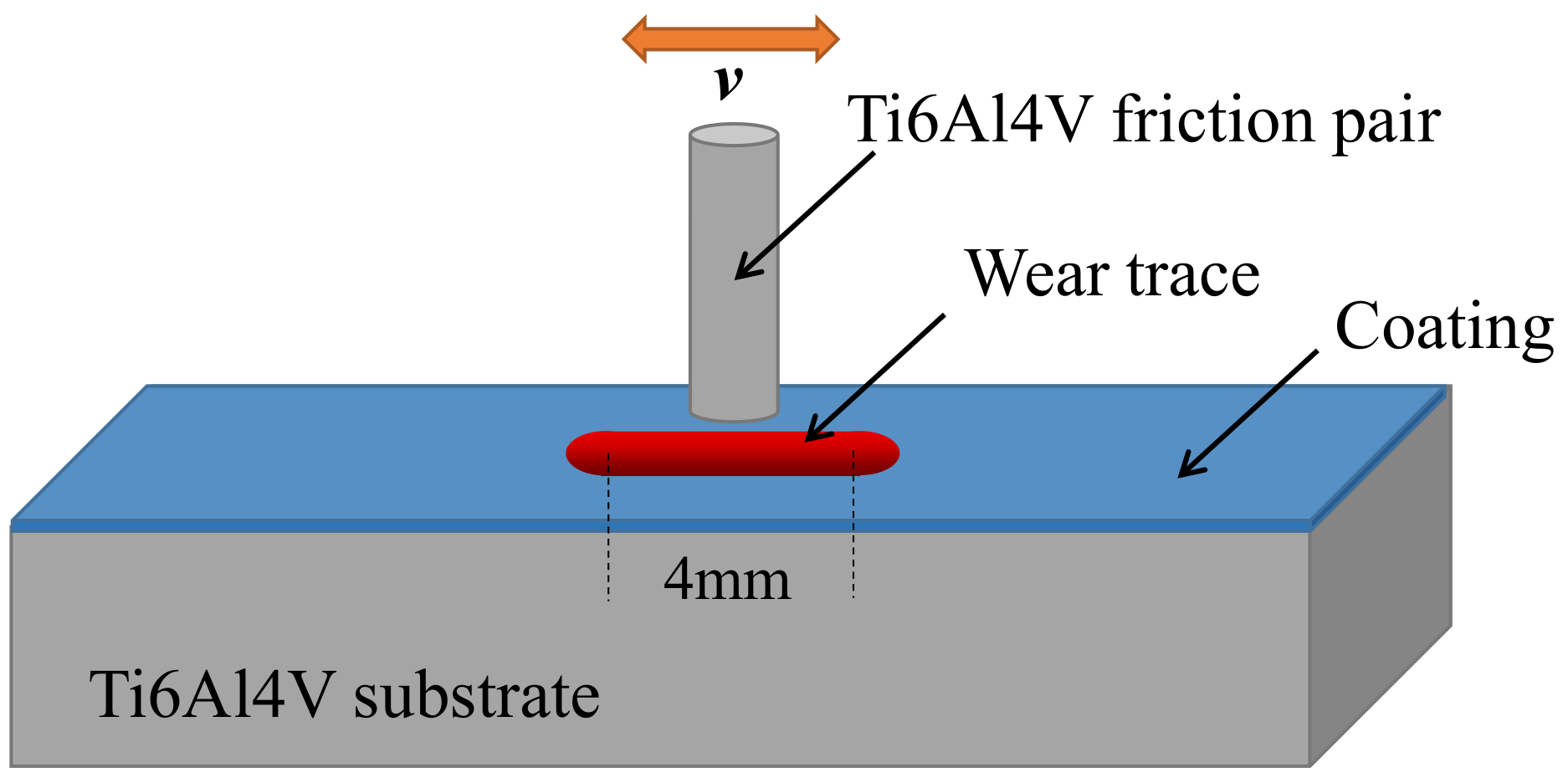


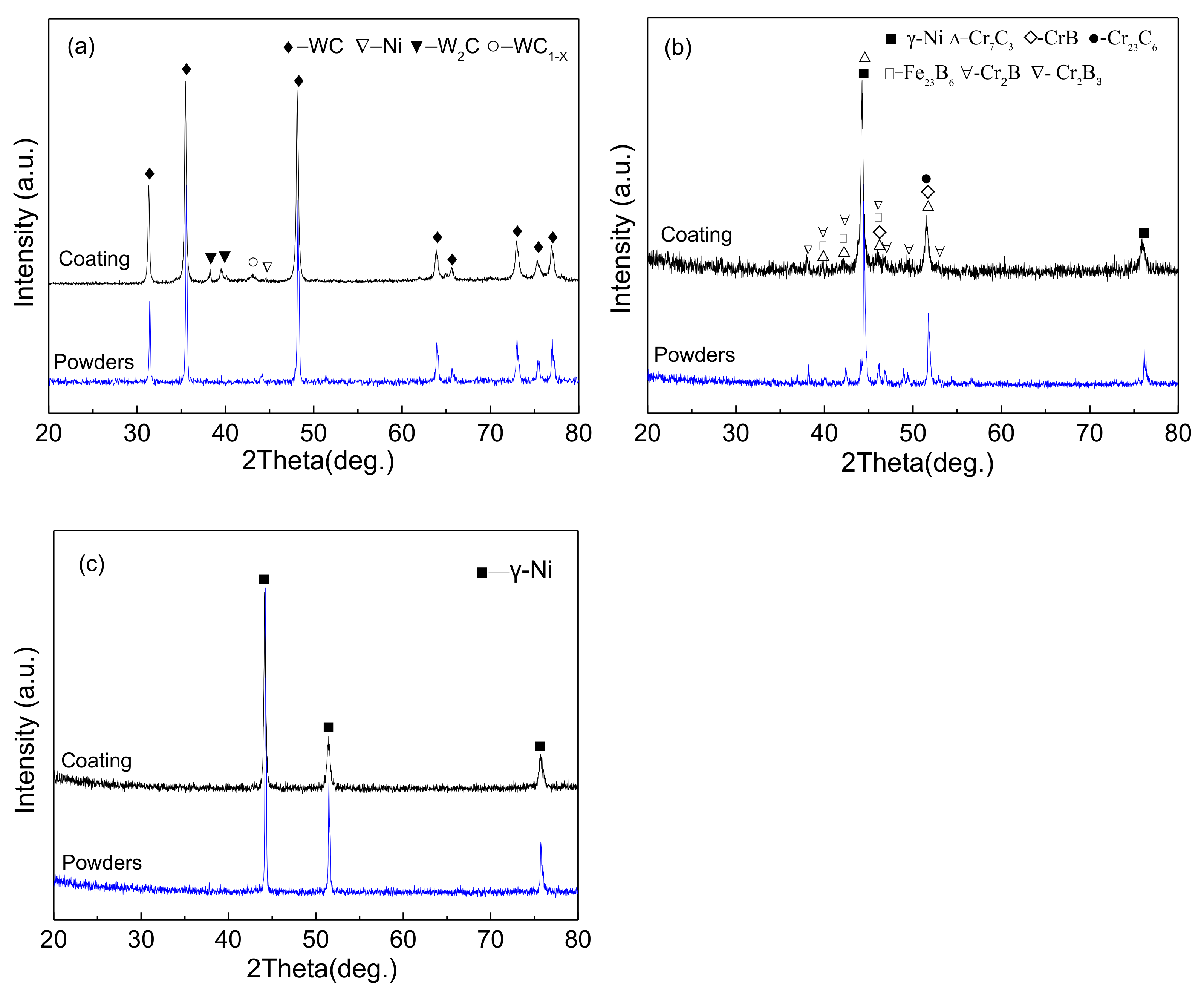



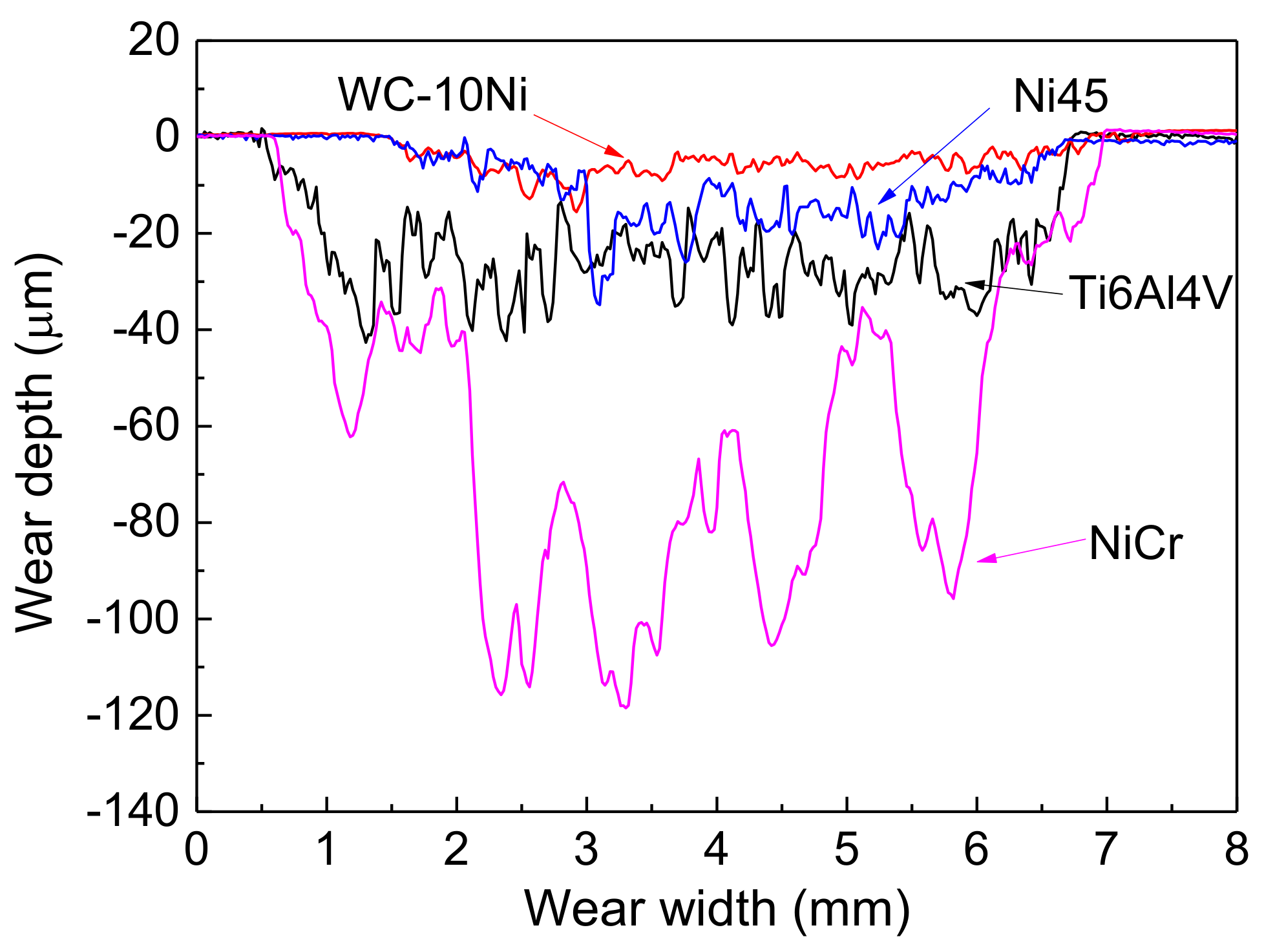
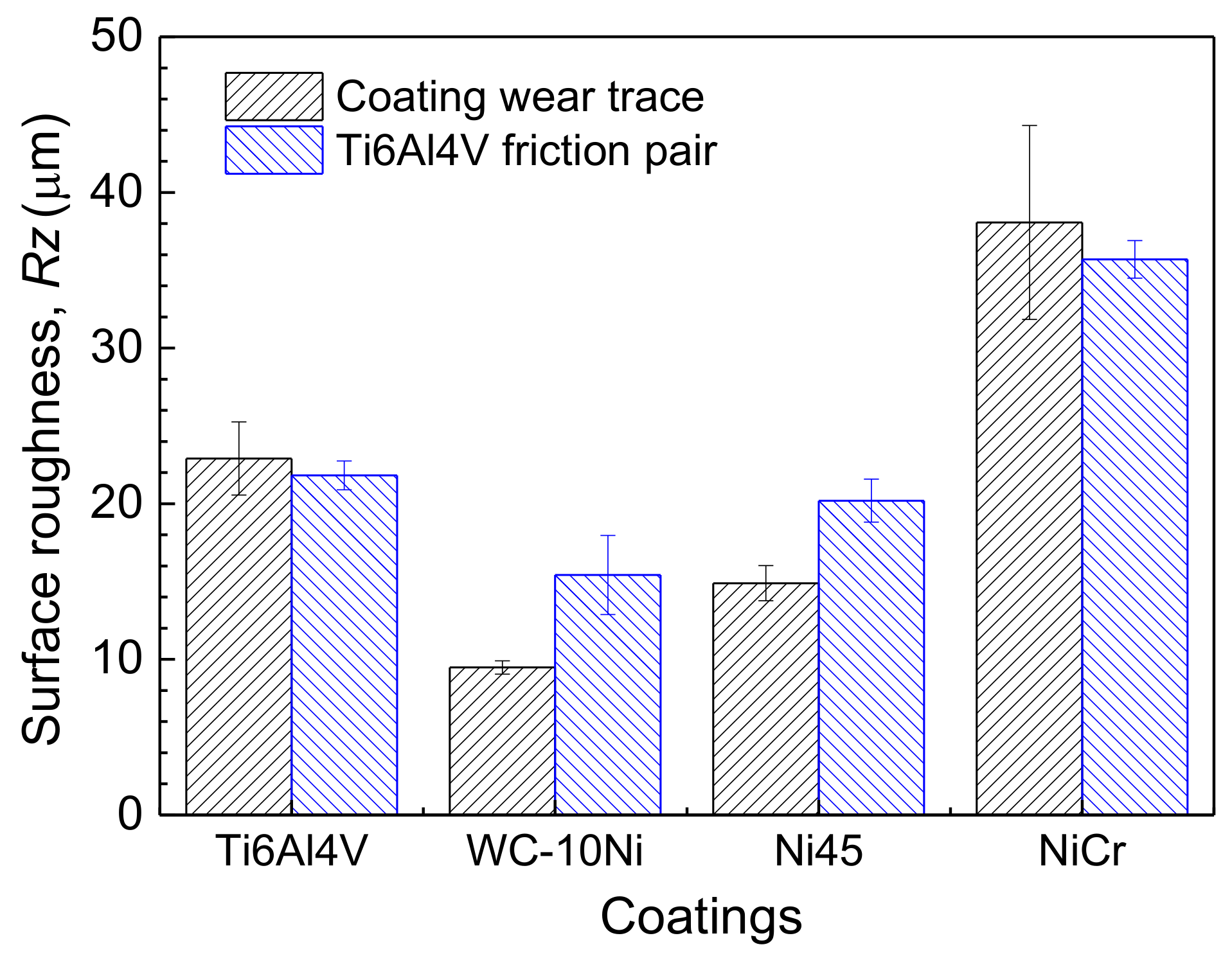
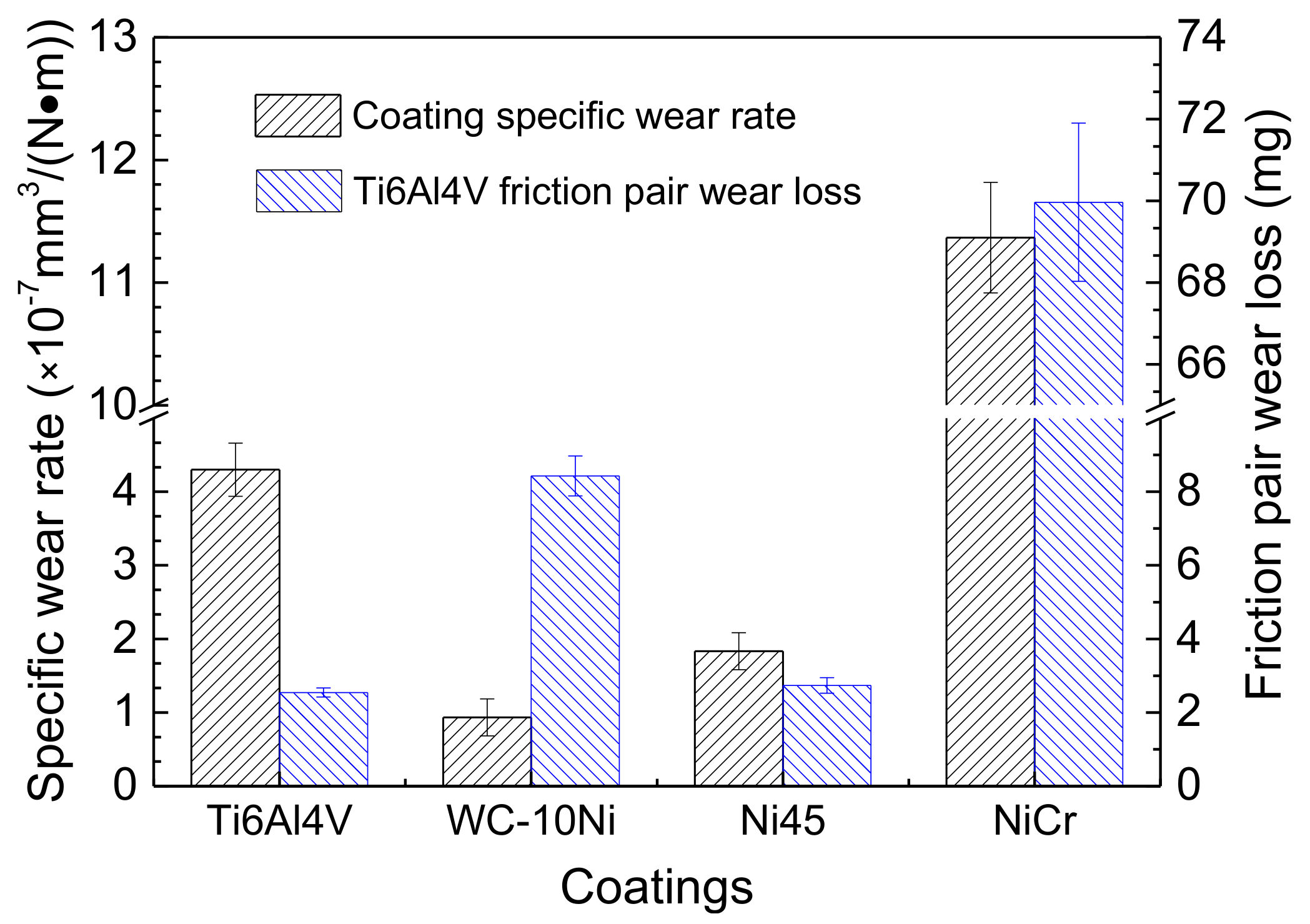
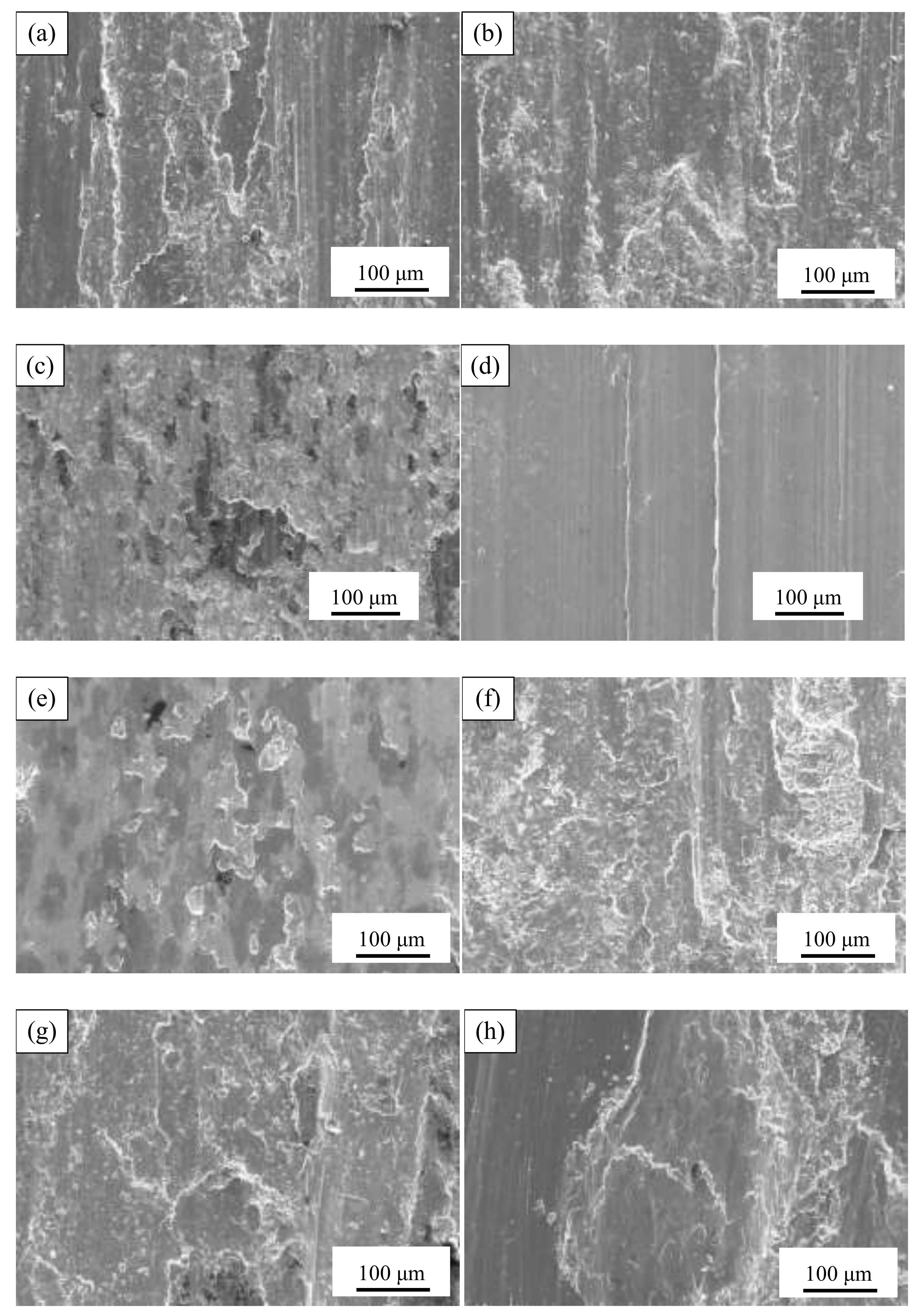
| Element | WC | Ni | Cr | Fe | B | Si | C |
|---|---|---|---|---|---|---|---|
| WC-10Ni | 90 | 10 | - | - | - | - | - |
| Ni45 | - | Bal. | 8.00 | ≤10 | 2.0 | 3.5 | 0.05 |
| NiCr | - | 80 | 20 | - | - | - | - |
| Parameters | Value |
|---|---|
| Oxygen | 950 L/min |
| Kerosene | 24 L/h |
| Powder feed rate | 100 g/min |
| Spray distance | 400 mm |
Publisher’s Note: MDPI stays neutral with regard to jurisdictional claims in published maps and institutional affiliations. |
© 2022 by the authors. Licensee MDPI, Basel, Switzerland. This article is an open access article distributed under the terms and conditions of the Creative Commons Attribution (CC BY) license (https://creativecommons.org/licenses/by/4.0/).
Share and Cite
Du, P.; Liu, C.; Hu, H.; Zhang, C.; Fan, M.; Gao, M.; Chen, T. Study of the Tribological Properties of HVOF-Sprayed Ni-Based Coatings on Ti6Al4V Titanium Alloys. Coatings 2022, 12, 1977. https://doi.org/10.3390/coatings12121977
Du P, Liu C, Hu H, Zhang C, Fan M, Gao M, Chen T. Study of the Tribological Properties of HVOF-Sprayed Ni-Based Coatings on Ti6Al4V Titanium Alloys. Coatings. 2022; 12(12):1977. https://doi.org/10.3390/coatings12121977
Chicago/Turabian StyleDu, Pengcheng, Chang Liu, Hongyun Hu, Chunhui Zhang, Mingzhen Fan, Mingchuan Gao, and Tongzhou Chen. 2022. "Study of the Tribological Properties of HVOF-Sprayed Ni-Based Coatings on Ti6Al4V Titanium Alloys" Coatings 12, no. 12: 1977. https://doi.org/10.3390/coatings12121977





